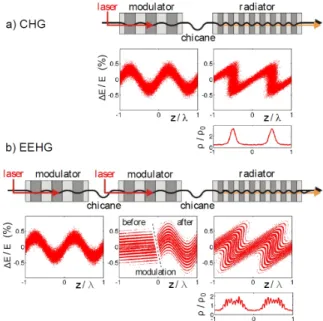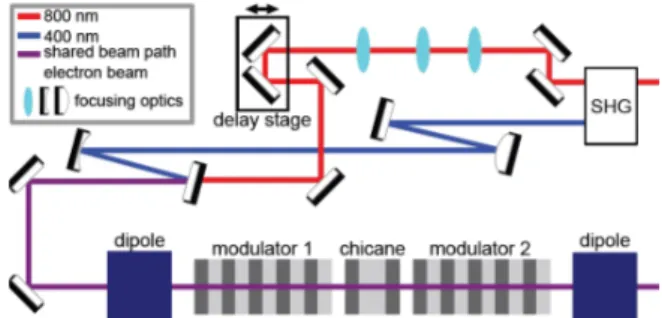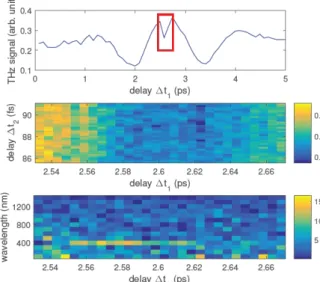PROGRESS TOWARDS AN EEHG-BASED SHORT-PULSE SOURCE AT DELTA
∗A. Meyer auf der Heide
†, F. H. Bahnsen, B. Büsing, F. Götz, S. Hilbrich, M. A. Jebramcik, S. Khan, N. M. Lockmann, C. Mai, R. Niemczyk, B. Riemann, G. Shayeganrad,
M. Suski, P. Ungelenk, D. Zimmermann
Zentrum für Synchrotronstrahlung (DELTA), TU Dortmund, 44227 Dortmund, Germany Abstract
The short-pulse source at the 1.5-GeV synchrotron light source DELTA, operated by the TU Dortmund University, enables the generation of sub-ps radiation pulses in the VUV regime based on coherent harmonic generation (CHG). As an upgrade, the employment of echo-enabled harmonic gen- eration (EEHG) is planned which allows to produce shorter wavelengths. Recent developments and measurements re- garding the twofold energy modulation required for EEHG are presented.
INTRODUCTION
The short-pulse facility at DELTA, a 1.5-GeV synchrotron light source operated by the TU Dortmund University, pro- duces ultrashort coherent synchrotron radiation pulses based on the coherent harmonic generation (CHG) technique [1].
The goal is to generate pulses with 50 fs duration at a wave- length down to 53 nm. The planned modifications towards the echo-enabled harmonic generation (EEHG) technique [2]
will allow to reach even shorter wavelengths.
Both, CHG and EEHG are based on the interaction of femtosecond laser pulses with electron bunches generating synchrotron radiation pulses at harmonics of the laser wave- length. In the CHG scheme (see Fig. 1a), an ultrashort laser pulse co-propagates with an electron bunch in an undulator ("modulator") tuned to the laser wavelength. With a laser pulse typically being 1000 times shorter than the electron bunch, the electron energy of a central slice of the bunch is modulated sinusoidally. In a subsequent magnetic chicane, the energy-dependent path lengths of the electrons result in periodic microbunches at intervals of the laser wavelength λL. This gives rise to coherent emission of synchrotron radiation at harmonics of the laser wavelength in a second undulator ("radiator"). The emitted powerPnat a harmonic nscales asPn∝b2n, wherebn∝exp(−n2)is the bunching factor which quantifies the quality of the microbunching.
This limits the usabilty of CHG radiation to harmonics of n≈5, due to the background of incoherent emission from the whole bunch.
In the EEHG scheme, originally proposed as an FEL seed- ing method, a twofold energy modulation is required. The CHG setup is expanded by another modulator and chicane (see Fig. 1b). In the strong first chicane, the sinusoidally modulated electron distribution is transferred into multiple
∗Work supported by BMBF (05K15PEA, 05K15PEB), MERCUR (Pr- 2014-0047), DFG (INST 212/236-1 FUGG) and the Land NRW.
†arne.meyeraufderheide@udo.edu
Figure 1: Sketches of the magnetic setups for CHG (a) and EEHG (b), the corresponding longitudinal phase space dis- tributions and the final longitudinal electron density.
stripes in phase space. The second sinusoidal modulation and subsequent second chicane result in microbunches with a periodic substructure. This allows for coherent emission at much higher harmonics compared to CHG, as the bunching factor now scales withbn ∝ n−1/3 [2]. In 2016, coherent emission at the 75th harmonic was demonstrated at NLCTA at SLAC [3].
THE SHORT-PULSE SOURCE AT DELTA
The short-pulse source at DELTA (see Fig. 2) was con- structed in 2011 to generate ultrashort coherent synchrotron radiation pulses in the VUV regime based on the CHG tech- nique [4, 5] as well as laser-induced THz radiation pulses extracted at a dedicated beamline (BL 5a) [6,7]. The param- eters of the source are listed in [8].
The seed pulses provided by a titanium:sapphire laser sys- tem are focused and guided via a beamline (BL 3) into the first of three independently powered sections of the U250 which serves as modulator, chicane and radiator. Alterna- tively, the seed pulses may be frequency-doubled beforehand.
The transverse and longitudinal overlap of seed pulse and electron bunch is diagnosed with screens and a streak camera at a diagnostics beamline (BL 4).
WEPAB010 Proceedings of IPAC2017, Copenhagen, Denmark
ISBN 978-3-95450-182-3 2582
Copyright©2017CC-BY-3.0andbytherespectiveauthors
02 Photon Sources and Electron Accelerators A05 Synchrotron Radiation Facilities
Figure 2: The short-pulse source in the northern part of DELTA comprises a laser laboratory, a beamline (BL 3) guiding seed pulses into the undulator U250, an in-air diag- nostics beamline (BL 4), an evacuated soft-X-ray beamline (BL 5), and a THz beamline (BL 5a).
For pump-probe experiments, a fraction of the seed pulse is guided to the soft-X-ray beamline (BL 5) operated by the Foschungszentrum Jülich as pump-pulse, while the CHG pulse probes a sample for photoemission spectroscopy. A first demonstration of a pump-probe experiment was recently performed [8].
Further downstream, the magnet lattice of the storage ring results in a longitudinal displacement of the modulated elec- trons which causes a sub-ps dip in the longitudinal electron density. This distribution gives rise to coherent emission of THz radiation.
EEHG Upgrade Status
For the magnetic setup of the EEHG scheme, two new 7-period undulators with 200 mm period length and power supplies were already ordered and delivered. The on-axis magnetic field was simulated with the software "Radia" [9]
and measured (see Fig. 3) in a self-built measuring bench equipped with a Hall-effect sensor mounted on a 3-axis motorized stage [10].
To align the three undulators required for EEHG in one straight section, the northern part of the DELTA storage ring (see Fig. 2) will be modified [11]. The 3◦dipoles adjacent to the U250 will be removed and compensated by increasing the bending angles of the subsequent dipoles. This extends the straight section to over 20 m which is sufficient for the new undulators serving as modulators, two yet to be designed chi- canes, the U250 serving as radiator, and several quadrupoles to shape the electron beam. A magnet lattice optimizing the electron beam properties for EEHG while preserving
Figure 3: Measurement of the on-axis magnetic field (red) of a new 7-period undulator together with simulation results (black).
Figure 4: Sketch of the setup used to seed with two laser pulses in different modulators. See text for details.
the beam parameters outside of the modified section is in preparation.
The twofold laser-electron interaction requires a second seed pulse with individual focusing and delay control. Such a scheme was tested with satisfactory results (see below).
TESTING EEHG-LIKE SEEDING
Recently, experiments with CHG and THz experiments were performed while seeding with two 800-nm pulses [8].
Since that setup did not allow for different focusing of pulses with equal wavelength, seeding with pulses of different wave- length was tested using both CHG undulators as modulators.
The setup is depicted in Fig. 4.
The two required laser pulses are provided by using a 400- nm pulse generated in a second harmonic generation (SHG) unit and the residual 800-nm laser pulse after passing the SHG crystal. On different beam paths, both laser pulses are focused into their respective modulator while the 800-nm beam path includes a motorized stage to introduce a delay
∆t1to control the longitudinal separation of the seed pulses.
In addition, the chicane between the modulators introduces a delay described by∆t2 =r56/(2·c), wherer56characterizes the strength of the chicane andcis the speed of light.
Influence on the THz Signal
Without having a EEHG radiator, the THz signal provided signatures the twofold energy modulation. A relative laser pulse delay in the picosecond regime generates two dips in the electron density and, thus, two THz pulses. Interfer- ence between the pulses causes a variation of the THz signal with pulse separation as shown in the upper part of Fig. 5.
The THz intensity decreases near zero delay since the seed pulses act on the same electrons, effectively reducing the number of electrons contributing to the coherent emission.
This condition, which is required for successful EEHG oper- ation, is sketched in Fig. 6. Here, the first chicane is tuned to generate optimum microbunching (r56 = 56 µm). The second modulation introduces a further phase-dependent broadening of the electron energy distribution. As shown in Fig. 6, an in-phase second modulation results in less broad- ening than a modulation at phase 180◦. Phase variations are controlled by changing the chicane strengthr56on the sub-µm scale and, thus, delaying the second seed pulse with Proceedings of IPAC2017, Copenhagen, Denmark WEPAB010
02 Photon Sources and Electron Accelerators A05 Synchrotron Radiation Facilities
ISBN 978-3-95450-182-3 2583 Copyright©2017CC-BY-3.0andbytherespectiveauthors
Figure 5: Top: THz signal for a coarse scan of the relative seed pulse delay. Center: THz signal for a scan of the puls separation with delay stage (∆t1) and fs delay variation (∆t2) by small changes of the chicane. Bottom: Fourier transform of each column of the delay scan (center). See text for details.
respect to the microbunches. The modulation of the THz radiation intensity with chicane strength is a signature of the seed pulses acting on the same electrons.
The central plot in Fig. 5 shows delay scans done with both, the motorized linear stage (∆t1) and the chicane (∆t2).
The range∆t1correspond to the marked region in the top part of Fig. 5. Delay∆t2is varied by small changes of the chicane strength around the value for optimum microbunching and its range corresponds to 8 optical cycles of the 400-nm seed pulse. In the bottom part of Fig. 5, the result of a Fourier transformation is shown. The Fourier coefficient at 400 nm noticeably increases over a range of approximately 150 fs (FWHM) indicating that here the second laser pulse overlaps with the microbunches. The length and chirp of each seed pulse in the respective modulator is not exactly known. The overlap range of 150 fs is consistent with a width of 106 fs (factor√
2) of the electric field and 75 fs of the intensity dis- tribution, if the pulse lengths are equal. This is a reasonable value for 40-fs laser pulses after passing mirrors, lenses and a vacuum window.
Influence on the Beam Lifetime
In a different approach to verify the zero-delay condition between the seed pulses as required for EEHG, the lifetime of a stored single electron bunch was measured while scanning the relative delay. With a reduced radiofrequency voltage of the storage ring, electrons which are modulated twice are lost when their increased energy deviation (see Fig. 6) exceeds the reduced energy acceptance.
The results of two subsequent scans of the relative delay are shown in Fig. 7. The beam lifetime significantly drops from 100 to below 30 minutes in the same delay region in which the chicane-dependent modulation of the THz signal was observed.
This procedure verifies the twofold modulation of the same electrons independent of the setting of the chicane.
ACKNOWLEDGEMENTS
We are pleased to thank our colleagues at DELTA and other institutes, particularly FZJ in Jülich, HZB in Berlin, DESY in Hamburg and KIT in Karlsruhe, for their continu- ous support and advice.
Figure 6: Left: Phase space distributions without second modulation (blue), after a second modulation with wave- length 2·λLat phase 0◦(red), and at phase 180◦. Right:
Projection of the distribution onte the electron energy axis.
Figure 7: Lifetime measurements of a stored single electron bunch as function of the relative delay of the seed pulses.
REFERENCES
[1] R. Coisson and F.D. Martini, "Free-electron relativistic scat- terer for UV-generation", in Physics of Quantum Electronics IX, edited by S. F. Jacobset al., Addison-Wesley, 1982.
[2] G. Stupakov, "Using the Beam-Echo Effect for Generation of Short-Wavelength Radiation", Phys. Rev. Lett., vol. 102, p.
074801, 2009.
[3] E. Hemsinget al., "Echo-enabled harmonics up to the 75th or- der from precisely tailored electron beams", Nature Photonics, vol. 10, pp. 507-511, 2016.
[4] H. Hucket al., "Coherent harmonic generation at the DELTA storage ring", inProc. 33rd Int. Free-Electron Laser Conf.
(FEL’11), Shanghai, China, 2011, pp. 5-8.
[5] S. Khanet al., "Generation of Ultrashort and Coherent Syn- chrotron Radiation Pulses at DELTA", Sync. Rad. News, vol.
26, pp. 25-29, 2013.
[6] P. Ungelenket al., "Spectral and temporal observation of laser- induced THz radiation at DELTA", inProc. Int. Particle Ac- celerator Conf. IPAC’13, Shanghai, China, 2013, pp. 94-96.
[7] C. Maiet al., "Time-resolved spectral observation of coherent THz pulses at DELTA", inProc. Int. Particle Accelerator Conf.
IPAC’16, Busan, Korea, 2016, pp. 105-108.
WEPAB010 Proceedings of IPAC2017, Copenhagen, Denmark
ISBN 978-3-95450-182-3 2584
Copyright©2017CC-BY-3.0andbytherespectiveauthors
02 Photon Sources and Electron Accelerators A05 Synchrotron Radiation Facilities
[8] S. Khanet al., "Pilot Experiments and new Developments at the DELTA Short-Pulse Facility", presented at IPAC’17, Copenhagen, Denmark, 2017, paper WEPAB009, this confer- ence.
[9] Radia,http://www.esrf.eu/Accelerators/Groups/
InsertionDevices/Software/Radia
[10] D. Zimmermann, "Aufbau eines Magnetmessstandes zur Feld- vermessung von Undulatoren bei DELTA", master thesis, TU Dortmund University, Germany, 2016.
[11] S. Hilbrichet al., "Plans for an EEHG-Based Short-Pulse Facility at the DELTA Storage Ring", inProc. Int. Particle Accelerator Conf. IPAC’15, Daejeon, Korea, 2015, pp. 363- 367.
Proceedings of IPAC2017, Copenhagen, Denmark WEPAB010
02 Photon Sources and Electron Accelerators A05 Synchrotron Radiation Facilities
ISBN 978-3-95450-182-3 2585 Copyright©2017CC-BY-3.0andbytherespectiveauthors


